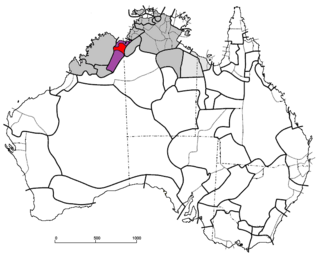
The Pama–Nyungan languages are the most widespread family of Australian Aboriginal languages, containing 306 out of 400 Aboriginal languages in Australia. The name "Pama–Nyungan" is a merism: it is derived from the two end-points of the range, the Pama languages of northeast Australia and the Nyungan languages of southwest Australia.
Guugu Yimithirr, also rendered Guugu Yimidhirr, Guguyimidjir, and many other spellings, is an Australian Aboriginal language, the traditional language of the Guugu Yimithirr people of Far North Queensland. It belongs to the Pama-Nyungan language family. Most of the speakers today live at the community of Hope Vale, about 46 kilometres (29 mi) from Cooktown. However, as of June 2020 only about half of the Guugu Yimithirr nation speak the language. As such, efforts are being made to teach it to children. Guugu Yimithirr is the source language of the word kangaroo.

The Warlpiri language is spoken by close to 3,000 of the Warlpiri people from the Tanami Desert, northwest of Alice Springs, Central Australia. It is one of the Ngarrkic languages of the large Pama–Nyungan family and is one of the largest Aboriginal languages in Australia in terms of number of speakers. One of the most well-known terms for The Dreaming, Jukurrpa, derives from Warlpiri.
Martuthunira is an extinct Australian Aboriginal language, that was the traditional language of the Martuthunira people of Western Australia.
Ngan'gi, formerly known as Ngan'gityemerri, and also known as Ngan'gikurunggurr, Moil/Moyle, Tyemeri/Tyemerri, Marityemeri, and Nordaniman, is an Australian Aboriginal language spoken in the Daly River region of Australiaʼs Northern Territory. There are three mutually intelligible dialects, with the two sister dialects known as Ngen'giwumirri and Ngan'gimerri.
Ngalakan (Ngalakgan) is an Australian Aboriginal language of the Ngalakgan people. It has not been fully acquired by children since the 1930s. It is one of the Northern Non-Pama–Nyungan languages formerly spoken in the Roper river region of the Northern Territory. It is most closely related to Rembarrnga.
Nyangumarta, also written Njaŋumada, Njangamada, Njanjamarta and other variants, is a language spoken by the Nyangumarta people and other Aboriginal Australians in the region of Western Australia to the south and east of Lake Waukarlykarly, including Eighty Mile Beach, and part of the Great Sandy Desert inland to near Telfer. As of 2021 there were an estimated 240 speakers of Nyangumarta, down from a 1975 estimate of 1000.
Kurrama is an Australian Aboriginal language. It is a dialect of Yindjibarndi, one of the Ngayarda languages of the large Pama–Nyungan family, with almost identical vocabulary and grammar, but speakers consider it to be a distinct language.

The Ngayarda languages are a group of closely related languages in the Pilbara region of Western Australia. The languages classified as members of the Ngayarda languages group are :

The Wunambal language, also known as Northern Worrorran, Gambera or Gaambera, is a moribund Australian Aboriginal language of Western Australia. It has several dialects, including Yiiji, Gunin, Miwa, and Wilawila. It is spoken by the Wunambal people.

Miriwoong, also written Miriuwung and Miriwung, is an Aboriginal Australian language which today has fewer than 20 fluent speakers, most of whom live in or near Kununurra in Western Australia. All of the fluent speakers are elderly and the Miriwoong language is considered to be critically endangered. However, younger generations tend to be familiar with a lot of Miriwoong vocabulary which they use when speaking Kimberley Kriol or Aboriginal English, and there is active language revitalization.
Yinjibarndi is a Pama–Nyungan language spoken by the Yindjibarndi people of the Pilbara region in north-western Australia.
Ngarla is a Pama–Nyungan language of coastal Western Australia. It is possibly mutually intelligible with Panyjima and Martuthunira, but the three are considered distinct languages.
Ngarluma and Kariyarra are members of a dialect continuum, which is a part of the Ngayarda language group of Western Australia, in the Pama–Nyungan language family. Some sources suggest that an extinct dialect, Jaburara, was a third member of the continuum. However, it is clear that Jaburara had a distinct identity that has been partly obscured by a collapse in the numbers of Jaburara speakers during the late 19th century, and there is some evidence that Jaburara may have instead been a dialect of Martuthunira.
Djaru (Tjaru) is a Pama–Nyungan language spoken in the south-eastern Kimberley region of Western Australia. As with most Pama-Nyungan languages, Djaru includes single, dual and plural pronoun numbers. Djaru also includes sign-language elements in its lexicon. Nouns in Djaru do not include gender classes, and apart from inflections, words are formed through roots, compounding or reduplication. Word order in Djaru is relatively free and has the ability to split up noun phrases. The Djaru language has a relatively small number of verbs, as compared to most languages, and thus utilizes a system of 'preverbs' and complex verbs to compensate. Djaru also has an avoidance language. Avoidance languages, sometimes known as 'mother-in-law languages', are special registers within a language that are spoken between certain family members – such registers are common throughout native Australian languages.
The Yapurarra or Jaburara, also rendered Yaburara, are an Aboriginal Australian people whose traditional lands are in the Pilbara region of Western Australia and the Dampier Archipelago.
The Ngarluma are an Indigenous Australian people of the western Pilbara area of northwest Australia. They are coastal dwellers of the area around Roebourne and Karratha, not including Millstream.
The Nhuwala are an Aboriginal Australian people of the Pilbara region of Western Australia.
The Panyjima, also known as the Pandjima/Banjima, are an Aboriginal Australian people of the Pilbara region of Western Australia.
The Mandara were an indigenous Australian people of the Pilbara region of Western Australia. They are extinct, having been absorbed into neighboring peoples, and their language is unrecorded.





